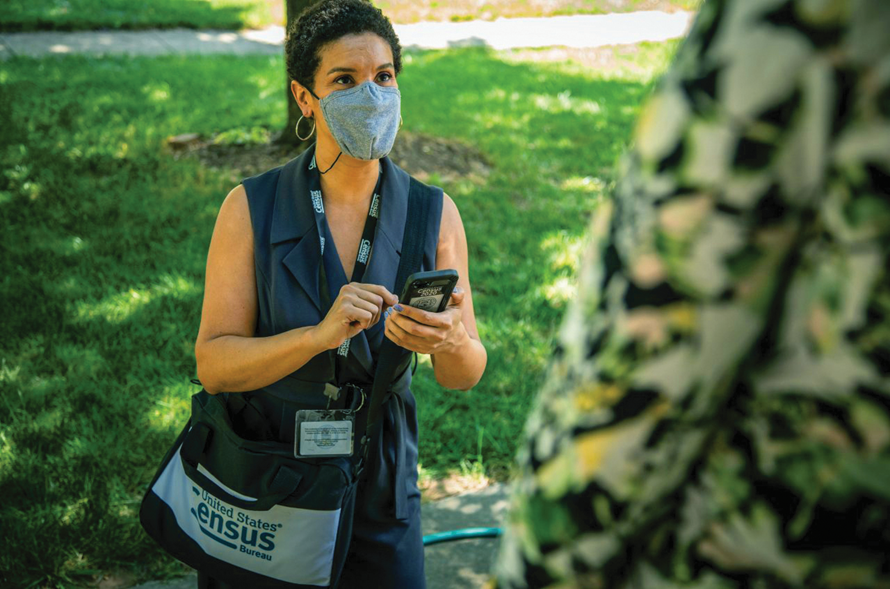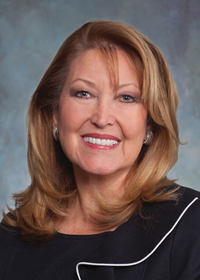 North Texans who have not completed the census form may soon hear a knock at the door as officials work to finalize the once-a-decade population count. The Census Bureau remains committed to health and safety during the coronavirus pandemic.
North Texans who have not completed the census form may soon hear a knock at the door as officials work to finalize the once-a-decade population count. The Census Bureau remains committed to health and safety during the coronavirus pandemic.
In these unprecedented times, there are many ways North Texans can help themselves and one another. They can pick up takeout at their favorite restaurant, take a walk around the neighborhood or pick up the phone and check in on a friend or relative. While people are thinking about how to stay healthy, they can also invest in their future. One way to do that is to fill out the census form.
The 2020 Census will mark the 24th time that the United States has counted its population since 1790. This year, as the nation grapples with the COVID-19 pandemic, the questionnaire is easier than ever to complete. North Texans are encouraged to fill out the census online by visiting www.2020census.gov. The form can be completed in about 10 minutes, and the process is safe and secure. Information can also be submitted by mail or over the phone, for those not comfortable answering the questions online.
An accurate population count across North Texas and other regions throughout Texas and the nation will determine how federal funding for essential services is spent. These services include education, transportation and healthcare. Census data also informs the make-up of congressional and legislative seats. Texas gained four seats after the 2010 Census for a total of 36.Additionally, each person counted helps inform billions in federal funding allocated annually.
The Dallas-Fort Worth area is the fourth-largest metropolitan area in the nation, with an estimated population of more than 7.5 million people. Since the 2010 census, the area has grown by more than 1 million people, continuing a pattern that goes back several decades. Sometimes, people need some assistance to fulfill their census obligation.
After a brief hiatus in the first few weeks of the pandemic, the US Census Bureau began to coordinate with federal, State, and local health officials to drop off 2020 Census questionnaire packets at the front doors of households in select cities in late May. This operation is contactless and follows the most current federal health and safety guidelines. It is done in areas where many households did not receive mail at their physical address. Additionally, to assist with the collection of data, the Census Bureau has begun to send reminder postcards to homes to encourage people to complete the census questionnaire.
To count the remainder of people, the Census Bureau will deploy census takers, who will be provided face masks that must be worn while conducting their work. This June, Census 2020 took a virtual road trip, to challenge each city to see who could encourage the most people to complete 2020 Census response forms. Officials visited North Texas on June 25.
In Texas, approximately 56% of residents have responded to the census. Updated data on self-response rates can be found by clicking here. In 2010, approximately 64% of Texans completed the census form themselves.
The last day to fill out the Census is October 31. Don’t wait until then to be counted. Spend some time while at home answering a few questions. It’s quick, easy and could have a profound impact on the region as it continues to grow.

A Message From Michael Morris, P.E.
Director of Transportation
COVID-19 has radically altered virtually everyone’s perspective. For the rest of 2020, we will be focused on staying healthy with an eye on how we can return to the things we have too often taken for granted.
Going out to eat with family and friends.
Taking the Trinity Railway Express to the American Airlines Center to watch a Stars or Mavs game.
Enjoying an outdoor concert or one of the many community events we’ve come to rely on during the spring.
We were unable to participate in these and many other activities as we were asked to stay home in order to help our valued medical professionals control the effects of the coronavirus pandemic that continues to grip the world.
And our professional lives look vastly different, with offices closing and employers asking their employees to work from home. It’s this last element of pandemic life that has the attention of transportation planners and policymakers. Traffic on our roadways declined in March, as cities and counties began to ask residents deemed “nonessential workers” to stay home. Toll road transactions, transit ridership and aviation travel fell more.
While the drop in traffic provided smoother commutes for essential workers, far fewer people using our transportation system has been tough on transportation funding. The federal government, through the CARES Act, delivered needed funding to transit agencies in North Texas and across the nation. Highway funding could be next, and NCTCOG’s planners and policymakers are preparing for that possibility.
There were some positives to the stay-at-home orders, as our region saw an improvement in air quality in the first days of the pandemic. Additionally, data shows a strong surge in the use of the region’s bicycle-pedestrian trails. Trails in some areas saw a doubling of activity.
We should take advantage of the current climate to aggressively improve our infrastructure for the benefit of those who call North Texas home today, as well as future generations.
We have done this before. During the Great Recession of 2008-2009, the American Recovery and Reinvestment Act provided the money to build necessary projects such as the DFW Connector.
The key is to be ready. We should prioritize infrastructure improvements that will ease unemployment increases and serve as a legacy for the future. We did it with the DFW Connector. We can do it again, taking advantage of historically low inflation and the strong desire of our neighbors to turn things around. How about high speed rail, D2 and the “Y” connector?
This crisis presents an opportunity to bring back public-private partnerships and to borrow money when interest rates are favorable. Additionally, we should focus on projects that will help the economy get going. The private sector is your friend in these times and can help you accomplish big projects. By acting now to jump start our economy, we can replenish the revenue lost through the decline in gas tax receipts or the slowdown in the sectors of the economy. Money, ideas, technology enhancements, and speed are a nice combination in times of great need.
As we seek to emerge from this terrible health crisis, let’s think big – as we did in 2009.
Advance high speed rail from Dallas to Houston and Fort Worth to Dallas. Build a Virgin Hyperloop Certification Center, introduce autonomous transit vehicles to help people move around the midtown development, and production at the General Motors assembly plant in Arlington. Advance electric vehicle recharging on induction loops in our freeway pavement. Help the private sector expand the North Tarrant Express (State Highway 183) to meet demand in fast-growing northeast Tarrant County.
While the stay-at-home orders have been relaxed, life will be different for some time. Yet, we have been through downturns before. And we recognize the responsibility of transportation in helping to usher in a return to normalcy. Our current priority as a region is to stay healthy. But we must also get the economy moving again. In transportation, we have a leadership role to play.
It’s time to turn our big ideas into big projects. After all … mobility matters, even more in difficult times.

Member Profile
Dianne Costa, Chair, Denton County Transportation Authority
From an early age, Dianne Costa was exposed to a broad range of transportation choices. Maybe the B-52 bombers she saw when her father, a supervisor at San Antonio’s Kelly Air Force Base, took her to see planes arrive inspired her.
Many members of her family served in the military, and she was able to get an up-close look at the aircraft that would transport them to faraway places. In those days, families could accompany their loved ones to the tarmac.
“I remember thinking, ‘This is an amazing bird, this airplane that is transporting my brother and cousins to another country,’” Costa said.
Maybe it was the train. Growing up, her aunt lived by train tracks, which piqued her interest in the job the trains were doing, what cargo they were hauling.
Or the bus. Her mother suffered from Retinitis Pigmentosa, a genetic eye disease that prevented her from driving. Public transportation was an essential part of how she, her mother and siblings got around. “There were five of us siblings, and we depended heavily on the bus system in San Antonio,” she said.
Going to the doctor, a movie or out to eat, buses were frequently a part of their lives. The bus stop was close, a block south of her house, making trips into town easier for the family.
Perhaps it was a combination of different modes of transportation that helped lead Costa to the position of chair of the Denton County Transportation Authority.
“You know, I guess I never really appreciated what the quality of my life would have been like had I not had that opportunity,” she said. “We never had to worry about the vehicle not starting or parking or gas. My mom obviously could never drive. So, had we not had that bus opportunity, I don’t know what the quality of our life would have been.”
A block to the north was a new project that would soon help move San Antonio. Construction on Interstate Highway 35 began when she was about 10. “The neighborhood kids and I would ride our bikes over there before they opened it up, throw our bikes across the fence, climb the fence and ride up and down I-35 before they opened it,” she said.
She even has a scar on her knee to prove she was there. “So, when I look at those experiences that I had with transportation that were very significant in my life, I think that really became the love of transportation for me because it affected me so personally,” she said.
Costa has been a member of the Denton County Transportation Authority since 2017 and its chair since 2019. She succeeded Charles Emery, the longtime leader of the transit agency who was instrumental in its founding in the early 2000s. In 2019, Costa was appointed DCTA's representative to the Regional Transportation Council, where she works cooperatively with the other members to craft solutions for the entire region.
DCTA is a significant part of the region’s transportation system. And just like other elements of that system, public transportation must evolve to continue serving its customers.
“We are in the business of moving people efficiently and each one of our communities needs solutions that fit their needs,” said Costa, a former mayor of Highland Village. “It’s not one solution fits all and we have to work with mobility companies and our communities to design the right solutions. In addition to moving people, DCTA can play a big part in helping communities plan and implement projects that make our communities more livable, walkable, bikeable and connected.”
DCTA is beginning a “comprehensive transformation initiative” that will help it continue serving one of the fastest-growing counties in Texas while thinking about strategic decisions to help cities in Denton County both now and for decades to come, she said. “These have significant potential for improving air quality and creating a new clean economy,” Costa said. “And the RTC has been and will continue to be a great partner, an important leader and investor in these important initiatives.”
DCTA and other transit agencies were profoundly affected by the coronavirus pandemic. Ridership throughout the region’s transit system fell sharply as stay-at-home orders were put in place. The region’s three transit agencies – DCTA, Dallas Area Rapid Transit and Trinity Metro – have helped one another throughout the crisis, cooperatively finding solutions to help keep their employees and passengers safe, she said.
DCTA and its transit partners have learned to adapt and rethink what is critical as COVID-19 redefines what “normal” looks like, she said.
“And we need to make sure our transit systems of the future reflect these fundamentals,” she said. “We will continue to learn and adapt and will build better, more connected communities as a result".
She sees the pandemic reshaping North Texas into a region with more low-cost options for residents. More bike trails. More sidewalks.
“Communities will be connected to transit hubs where trips can be performed across the region or just across the neighborhood or the local grocer or restaurant,” she said.
Read about how the transportation system is meeting the needs of the growing region in Progress North Texas 2020. An annual report developed each spring by the North Central Texas Council of Governments, Progress North Texas summarizes transportation system performance, recent accomplishments and what to expect in the future to meet continued population growth. This includes innovative methods of moving people and goods such as high-speed transportation and hyperloop technology.
Whether you are traveling by rail, roadway or trail getting there safely, reliably and efficiently is important. Progress North Texas 2020 examines the performance of the different mobility options and how they work together to advance the theme of Connecting the Dots of Regional Transportation. Air quality also remains important, as the Dallas Fort Worth area works toward compliance with the federal government’s air quality standards.
As the region continues growing, planners must also examine innovative ways to keep people connected to decision-making, include residents in public involvement processes and prioritize equitable policy-making decisions.
Congratulations to Louisa Hathcock, the winner of this year ’s competition. We asked the children of our staff to illustrate what this year ’s theme of
Connecting the Dots of Regional Transportation, means to them. Louisa’s artwork is on the cover of Progress North Texas 2020.
For more information or copies of Progress North Texas, contact Brian Wilson at (817) 704-2511 or bwilson@nctcog.org. This report is also available online at www.nctcog.org/ourregion.

Wherever your daily travels take you, you are the expert. You know what roadway improvements could help you get to work faster.
Or maybe it’s an improvement to part of the region’s growing transit network that could help you reach a medical appointment. In the age of COVID-19, when many people have more time to devote to active pursuits such as bicycling or walking, perhaps you see opportunities to expand the regional Veloweb.
Whatever you have noticed, there is now an opportunity to inform planners of the need. You don’t even have to wait for the next public meeting. The North Central Texas Council of Governments Transportation Department is now accepting public input through a new online map tool. The Map Your Experience application is easy to use and designed to help NCTCOG staff use public input to develop innovative solutions for regional transportation issues.
This is the latest addition to NCTCOG’s public involvement efforts devoted to facilitating a dialogue with people who use the transportation system every day. Input will provide real-time suggestions that could prove valuable in efforts to improve the system for all users.
NCTCOG staff is committed to a transparent public involvement and planning process and is now utilizing this innovative technology to crowd source transportation system input. Whether comments are about traffic, safety, walking and biking or any other mode, they assist in improving regional transportation by showing areas of need based on everyday travel experiences. Once public needs are identified, NCTCOG can work with regional partners such as cities and transit agencies to develop solutions.
The tool is currently in a testing phase and was launched during the COVID-19 pandemic to engage people while they stayed home. The tool will continue to serve as a means of gathering public input in the future as technology becomes more integrated into people’s lives.
Members of the public can provide as many comments as they wish and browse and comment on pins placed by others on the map. Providing personal information is optional and not visible to others in the tool. However, users are asked to provide their ZIP code to help staff better serve their community as well as communities across the region. ZIP codes allow for additional analysis capabilities for important topics such as equity and foreign language needs during the public engagement process.
Staff will reassess the tool in the fall of 2020 to ensure it is fully functional and meeting user needs. Comments from the test period will be used to guide upcoming planning efforts, including an update to Mobility 2045, the region’s long-range Metropolitan Transportation Plan. Staff will analyze the comments to compare current plan recommendations and identify places with additional transportation needs in order to develop innovative solutions that improve the quality of life in North Texas. Be heard. Help plan for the future at www.nctcog.org/mapyourexperience.
The silver lining of the COVID-19 pandemic may very well be the surge in active transportation. As stay-at home orders spread across the State in mid-March, regionally, freeway volumes and transit ridership declined, while the number of bicycling and walking trips skyrocketed. Data from bicycle and pedestrian counters along Dallas-Fort Worth area trails revealed a significant average daily increase in the number of trail users throughout March, as compared to last year’s figures.
Data from bicycle and pedestrian counters along Dallas-Fort Worth area trails revealed a significant average daily increase in the number of trail users throughout March, as compared to last year’s figures. Activity on trails throughout the region was up substantially.

| Bicycling activities have increased substantially throughout Dallas-Fort Worth since the COVID-19 pandemic forced many of the region’s employees to stay home. Trails continue to be well used as people turn to their bicycles for transportation and recreation. |
Data further shows that residents throughout the Dallas-Fort Worth area have continued to walk and bike on the trails in higher numbers, even as the region has begun to reopen, suggesting that residents continue to integrate more walking and biking activities into their daily routines.
This year, Bike Month, which is traditionally celebrated throughout May, took a different form. Workplaces across Dallas-Fort Worth are accustomed to marking Bike to Work Day in mid-May, however with so many nonessential businesses asked to keep their employees at home, Bike to Work Day, and Bike Week have been moved to the fall.
The League of American Bicyclists postponed this year’s Bike to Work Week until September 21-27; Bike to Work Day taking place on September 22, to coincide with Car Free Day, when people are encouraged not to drive alone, opting instead for different transportation choices, including bicycles. With many people still working from home this summer, Bike to Work Day may still have a different look in Dallas-Fort Worth in September. Regardless of how things progress with COVID-19, North Texans are encouraged to continue embracing bicycling as a transportation option and for exercise.
This was the approach taken this spring, when priorities suddenly changed. Many agencies and community groups viewed the postponement of Bike to Work Day as an opportunity to support bicycling through a more holistic approach. Rather than focusing on a one-day event, support for active transportation was promoted throughout the entire month, with a greater focus on bicycling as an important factor to maintaining physical and mental health, traveling to essential service providers and running errands that would otherwise be short trips taken by automobile.
NCTCOG and its partners continue to pursue improvements to bicycle-pedestrian infrastructure. The 19-mile A-train Rail Trail was completed late last year, and work continues on a project to link downtown Dallas to downtown Fort Worth through a network of trails winding through several North Texas communities. These are just two examples of how the region is developing its bicycle-pedestrian infrastructure to open new options for residents to get where they want to go, whether that’s work or school, or they just want to get some exercise.
Visit www.nctcog.org/Veloweb to learn more about the planned regional trails and www.nctcog.org/Bikeweb for links to various local trails in communities throughout the region.
Imagery provided by Getty Images, DCTA and NCTCOG staff.